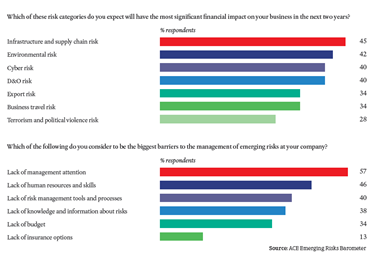Tomorrow’s captive owners are likely to be based in India, China or Brazil
As economic power moves eastwards, tomorrow’s captive owners are just as likely to be based in India, China or Brazil as they are to be based in the UK or the US.
Ever since the financial crisis shook up the global economy, it is clear the world is changing. There has been a shift away from the dominance of the mature Western economies towards those in the rapidly developing world. With obvious attention on the BRIC (Brazil, Russia, India and China) nations in recent years, attention is now turning to the MINTs (Mexico, Indonesia, Nigeria and Turkey) as growth in the maturing BRICs slows down. All eight nations are tipped to dominate the world stage by 2050, according to World Bank predictions.
Reflected in this shift is the rise of a new type of global company – the emerging-market multinational. Not only do these organisations have a sophisticated approach to risk management, they are also more likely to consider captive insurance than their predecessors, thanks to wake-up call events and maturing local insurance markets.
“Because these markets are developing, there is greater awareness of exposures, and as they become wealthier they become the centre of multinational businesses,” says Paul Hopkin, technical director of Airmic.
Among the better-known brands are Tata, ArcelorMittal, Infosys, Oberoi, Aditya Birla, Lenovo, Cemex, Huawai, ZTE, Bharti Airtel, Ranbaxy and Embraer. Several already have captive insurers, particularly to finance their international risks. This includes Tata Steel Europe, which self-insures through its captive, Isle of Man-based Crucible Insurance Company Ltd.
One of the case studies in Airmic’s long-awaited Roads to Resilience report is Jaguar Land Rover, owned by Tata Motors. “These are international companies located out of developing BRIC-type economies,” says Hopkin. “Talking to the risk managers who work for and in the subsidiaries they own, it is clear they genuinely seek to practice the risk management message. The subsidiaries in the UK of companies owned by organisations in BRIC countries are wanting to build a reputation and build good risk management standards right throughout
the organisation.”
The challenges for captive managers in attracting the business of the BRICs is demonstrating the value self-insurance holds at a time when pricing in the commercial insurance market is so competitive. The influx of capacity from capital markets investors into the insurance industry has put further downward pressure on rates in recent years. In addition, the benign catastrophe year in 2013 means there is plentiful capacity and none of the market dislocations that might have prompted captive growth in previous cycles.
Dealing with closed and immature local reinsurance markets presents another challenge. “The issue with India and China is moving the money out of the country,” explains Clive James, group chief operating officer at Kane. “Where we’ve seen the growth and potential growth is for Indian and Chinese companies looking at their risks outside of those particular countries. The classic would be Tata, which has a lot of subsidiaries globally and is placing its insurance risks outside of India into a captive.”
Wake-up calls
While commercial insurance premium rates are soft, particularly in competitive emerging insurance markets, volatility in pricing has also been a feature of the past two to three years. Catastrophe losses have helped to underline the appeal of captive insurance, with reinsurance rates rising dramatically in the aftermath of Asian catastrophes in 2011, most notably the Thai floods and Japanese earthquake and tsunami. These events also illustrated how interconnected the world and its supply chain risks are, with flooded industrial estates in Bangkok causing widespread business interruption.
Captive insurers can help organisations avoid this volatility in pricing and allow them more direct access to the reinsurance market. “One of the reasons why Asian companies have not produced many captives is because the insurance market has been relatively cheap,” says James. “That has changed. For example, incidents such as the Thailand floods and political unrest do have an effect on premiums and, in a lot of cases, claims from the Thai floods have still not been paid. That has caused the risk managers of these organisations to rethink what they are paying the premiums for.
“The decision to set up a captive all depends on the parent company,” he continues. “The corporations within those [BRIC] economies are growing to such a size – they’re getting more sophisticated with risk management because it is a bigger part of their cost equation and premium spend is a bigger part of their budget, so naturally that focuses the mind. Second, these corporations are becoming more regional as well as global, so they’re crossing borders and having risk management issues that they perhaps wouldn’t have locally.
“A captive in certain circumstances does provide a good solution for them and when they’re perhaps using one global market, that does make a captive option quite opportunistic,” he concludes. “In terms of sophistication, they’re looking for alternative ways to perhaps access the reinsurance market so there are some financial structures out there that these economies are looking at.”
The decision for a parent company based in an emerging market is where to locate its captive. Does it opt for an onshore local domicile that offers close proximity to the parent, a familiar regulatory and legal system and, of course, the same language? Or does it choose an established offshore captive domicile, with what is likely to be more favourable tax treatment, a long track record and credentials, more innovative regulation and a broader infrastructure to serve its captive needs?
Some regions aim to offer both, with Labuan an increasingly popular choice among Asian parents and currently ranking 25th by number of licences globally (its licences grew to 41 from 34 in 2012). It also has a strong reputation for takaful structures, which could prove attractive to parents based in Islamic countries.
“Labuan is growing, but politically there are issues in terms of certain countries going to Malaysia,” says James. “Likewise with certain companies going to Singapore. Singapore is a sophisticated centre for captives but most of its market is still Australia and it doesn’t have the cell legislation that Labuan has.
“The Bermudas, Guernseys and Caymans of this world still have a part to play,” he continues. “A number of these companies or representatives will go to London anyway as a matter of course to access the reinsurance market, so somewhere near London often makes sense. The major domiciles will continue to take on most of the new business, as it doesn’t matter where that business emanates from, and that will probably not change.”
Bermuda woos LatAm
Latin America is holding the attention of the captive community thanks to a steady growth in alternative risk transfer programmes, notes Marsh in its most recent benchmarking study.
Many LatAm corporations are well positioned financially to consider a larger self-insured retention in combination with traditional risk transfer options, and are eager to improve their understanding of the business benefits, operational aspects, and financial benefits of using captives.
“We feel there are some good opportunities in South America provided the captive model works for that country,” says Kane’s Clive James. “It works for Brazil, but there are still restrictions on getting reinsurance premiums out. You’ve got to offer it to local insurers first, which does put a bottleneck on reinsurance for captives. But South America generally is a developing area and we see there are some good opportunities there. As an organisation, we are optimistic about how that’s developing.”
In Latin America, semi-governmental agencies or organisations guaranteed by a government tend to dominate the captive market, with a heavy focus on commodities, according to Nearshore Americas. The obvious options for parent companies in Latin America is to locate their captives in offshore domiciles such as Bermuda, Cayman or Barbados. At present, there is no local domicile of choice in South America.
“When the Bermuda conference was on, they specifically geared it towards Latin America so risk managers and organisations in LatAm are seeing Bermuda as a home for captives because of its reputation and history – and also logistically it is closer,” says James. “Bermuda would be the place they would head to by default.”
Bermuda has set up tax information exchange agreements (TIEAs) with a number of Latin American countries and this has helped it win a number of new formations, according to Shelby Weldon, director of licensing and authorisation at the Bermuda Monetary Authority. “The Bermuda market has spent some time in Latin America talking about Bermuda as a viable captive domicile and we have seen some formations.
“I would suspect that when multinationals in Latin America look at jurisdictions to set up captives in, Bermuda will continue to be one of the first jurisdictions that come into their discussions,” he continues. “I know Bermuda is not alone in seeking captive business from that market but we are well placed to take advantage of the growing economies in Latin America and the increased interest in captive solutions. I’ve had the opportunity to spend some time in Latin America and Bermuda has a very good reputation there.”




















No comments yet